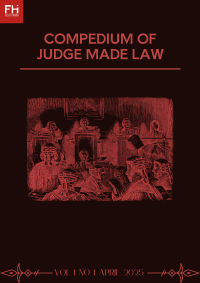Application Of Primum Remedium Principle in Corruption Criminal Acts In Decision (Number 46/Pid.Sus.TPK/2024/PN Mks)
Abstrak
This study aims to find out two things, namely the first to find out the legal considerations of the Panel of Judges in applying the primum remedium principle in decision Number 46 / Pid.Sus.TPK / 2024 / PN Mks and the second to find out the application of the Primum Remedium Principle in Corruption Crimes in Decision Case Number 46 / Pid.Sus.TPK / 2024 / PN Mks has met the legal objectives. The method in this study is to use normative legal research, the type of research is carried out by studying the laws and regulations in society related to the problems that the author is studying. The results of the study revealed that the legal considerations by the Panel of Judges in decision number 46 / Pid.SUS.TPK / 2024 / PN.Mks, have applied the primum remedium principle by imposing imprisonment and additional compensation in the form of compensation commensurate with state losses. Although this case meets the requirements for applying a restorative justice approach because the value of state losses is relatively small. Apart from this controversy, the Judge's considerations in the decision are in accordance with applicable legal regulations. ²The application of the primum remedium principle in Decision Number 46/Pid.Sus.TPK/2024/PN Mks has attempted to fulfill the three objectives of the law, namely the aspect of justice, the aspect of legal certainty, and the aspect of benefit. However, in the decision, the Panel of Judges prioritized legal certainty over justice and benefit. This can be seen from the decision to impose a 1-year prison sentence and a replacement fee of IDR 50,000,000, which shows the firmness in the application of the sentence. However, in terms of justice and benefit, there is still room for improvement, especially related to the impact of prevention and deterrent effects on future corruption crimes. The recommendation or suggestion given by the author is that the prosecutor's office in this decision needs to review the application of the SE Attorney General for Special Crimes Number B1113/F/Fd.1/05/2010 for corruption cases with small state losses, by considering the efficiency of case handling costs and the effectiveness of recovering state losses. For the Panel of Judges in handing down a verdict on corruption crimes, it is best to consider the balance between the three aspects of legal objectives (justice, legal certainty, and benefit) to achieve maximum deterrent effect.
Referensi
A. Badjuri, “Peranan Komisi Pemberantasan Korupsi (KPK) sebagai lembaga anti korupsi di indonesia,” J. Bisnis dan Ekon. (JBE), vol. 18, no. 1, pp. 84–96, 2011.
R. S. B. Sitorus, W. Watonnah, A. E. Dewi, and H. Widiyani, “Optimalisasi Pemberantasan Korupsi Di Indonesia,” J. Pahlawan, vol. 6, no. 2, pp. 1–8, 2023, doi: 10.31004/jp.v6i2.22810.
W. H. Suyatmiko, “Memaknai Turunnya Skor Indeks Persepsi Korupsi Indonesia Tahun 2020,” Integritas J. Antikorupsi, vol. 7, no. 1, pp. 161–178, 2021, doi: 10.32697/integritas.v7i1.717.
F. S. Pahlevi, “Strategi Ideal Pemberantasan Korupsi Di Indonesia,” Al-Syakhsiyyah J. Law Fam. Stud., vol. 4, no. 1, p. 44, 2022, doi: 10.21154/syakhsiyyah.v4i1.4251.
F. Pahlevi, “Pemberantasan Korupsi di Indonesia Perspektif Legal System Lawrence M. Freidmen,” El-Dusturie, vol. 1, no. 1, 2022, doi: 10.21154/eldusturie.v1i1.4097.
B. S. Badaru, “Journal of Lex Theory (JLT),” J. Lex Theory, vol. 1, no. 2, pp. 122–135, 2022, [Online]. Available: http://download.garuda.kemdikbud.go.id/article.php?article=2906157&val=25506&title=Peran Kepolisian Dalam Penegakan Hukum Terhadap Aksi Unjuk Rasa Mahasiswa Yang Anarkis Di Kota Makassar
L. Yumna and A. Taufik, Sosiologi, Hukum, Sosiologi Hukum. 2023.
Nuzul Fajrin and M. Fauzi Ramadhan, “Tinjauan Yuridis Tindak Pidana Pembunuhan Atas Dasar Membela Diri,” Qawanin J. Ilmu Huk., vol. 4, no. 1, pp. 48–59, 2024, doi: 10.56087/qawaninjih.v4i1.390.
E. Fauzi, M. Visar Sinatrya, N. Daru Ramdhani, R. Ramadhan, and Z. Muhammad Rasid Safari, “Pengaruh kemajuan teknologi informasi terhadap perkembangan akuntansi,” J. Ris. Pendidik. Ekon., vol. 7, no. 2, pp. 189–197, 2022, doi: 10.21067/jrpe.v7i2.6877.
M. F. Ramadhan, A. Asis, and A. M. Muin, “Law Enforcement Of The Crime Of Illegal Fishing In The Waters Area Of Pangkajene Regency And The Islands,” vol. 11, no. 3, pp. 1904–1909, 2022, doi: 10.35335/legal.
E. R. Toule M., “Eksistensi Ancaman Pidana Mati Dalam Undang-Undang Tindak Pidana,” J. Huk. PRIORIS, vol. 3, no. 3, pp. 103–110, 2013.
S. Rasul, “Penerapan Good Governance di Indonesia dalam Upaya Pencegahan Tindak Pidana Korupsi,” Mimb. Huk. - Fak. Huk. Univ. Gadjah Mada, vol. 21, no. 3, p. 538, 2012, doi: 10.22146/jmh.16276.
Y. R. Manalu, “Justice Collaborator dalam Tindak Pidana Korupsi,” Lex Crim., vol. IV, no. 1, pp. 151–152, 2015.
E. Yuhermansyah and Z. Fariza, “Pidana Mati dalam Undang-Undang Tindak Pidana Korupsi (Kajian Teori Zawajir dan Jawabir),” LEGITIMASI J. Huk. Pidana dan Polit. Huk., vol. 6, no. 1, pp. 156–174, 2017, doi: 10.22373/legitimasi.v6i1.1848.
E. Zahara Lubis, “Jurnal Administrasi Publik Dampak Melawan Hukum Dalam Tindak Pidana Korupsi Impact Against the Law in Corruption,” Jap, vol. 7, no. 2, pp. 107–116, 2017.
N. Qamar et al., “Metode Penelitian Hukum (Legal Research Methods),” no. December, p. 176, 2017.
Ahmad Syarbaini, “Konsep Korupsi Menurut Perspektif Hukum Pidana Islam,” J. Tahqiqa J. Ilm. Pemikir. Huk. Islam, vol. 16, no. 1, pp. 1–14, 2022, doi: 10.61393/tahqiqa.v16i1.48.
D. Latumaerissa, “Tinjauan Yuridis Tentang Penerapan Ancaman Pidana Mati Dalam Tindak Pidana Korupsi,” Sasi, vol. 20, no. 1, p. 8, 2014, doi: 10.47268/sasi.v20i1.341.
Johana Olivia R., “Alasan Pemberhentian Penyidikan Suatu Tindak Pidana Korupsi,” Lex Crim., vol. III, no. 4, pp. 93–102, 2014, [Online]. Available: https://ejournal.unsrat.ac.id/index.php/lexcrimen/article/view/6103%0Ahttps://ejournal.unsrat.ac.id/index.php/lexcrimen/article/download/6103/5609
A. Kep, D. Penguatan, R. Kemenristekdikti, U. Nomor, T. Tentang, and M. Uang, “De Jure De Jure,” J. Penelit. Huk., vol. 19, no. 3, pp. 339–348, 2019.
##submission.copyrightStatement##
##submission.license.cc.by-sa4.footer##






